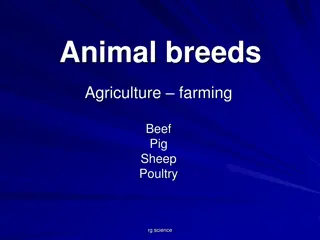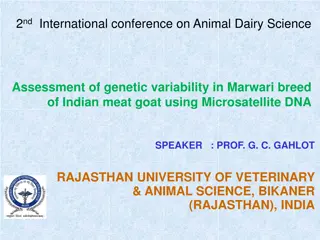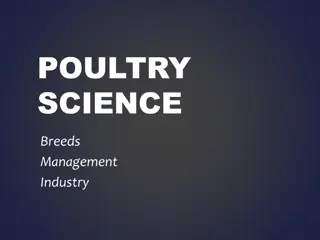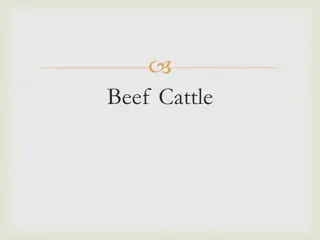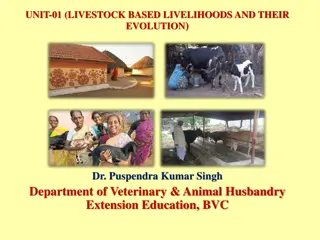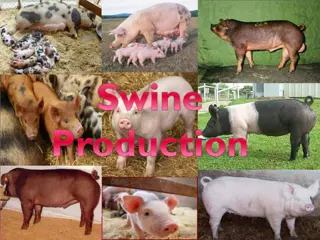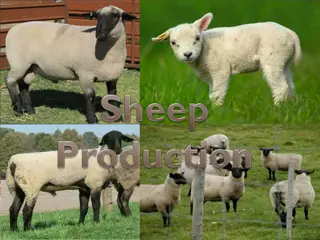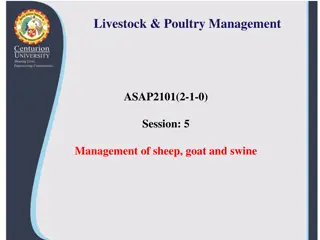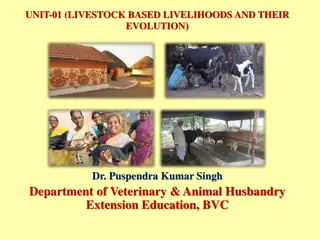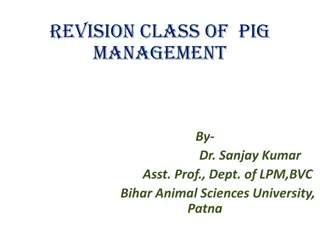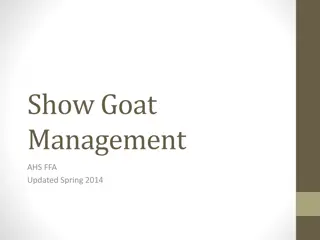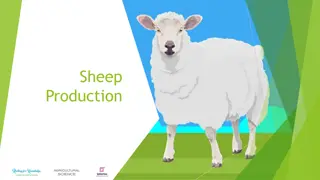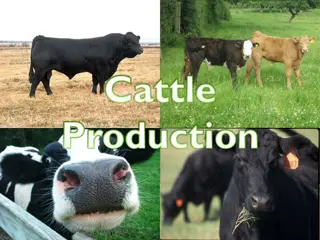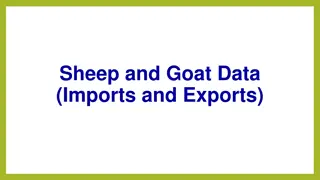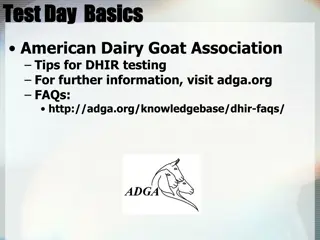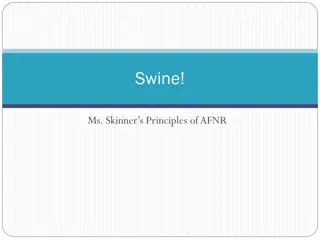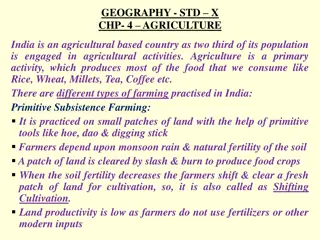Understanding Goat Farming: Terminology, Breeds, and Management
Explore the world of goat farming through key aspects like terminology, breeds including Angora and Boer, and effective management practices. Gain insights into goat behavior, growth, nutrition, and health evaluation for successful farming.
Download Presentation

Please find below an Image/Link to download the presentation.
The content on the website is provided AS IS for your information and personal use only. It may not be sold, licensed, or shared on other websites without obtaining consent from the author. Download presentation by click this link. If you encounter any issues during the download, it is possible that the publisher has removed the file from their server.
E N D
Presentation Transcript
OBJECTIVES Terminology Breeds Management Practices Feeding and Nutrition Animal Behavior Animal Growth and Development Animal Health Evaluation
BUCK Sexually mature male
DOE/NANNY A sexually mature female goat
WETHER A castrated male
KID A young goat
KIDDING Act of giving birth in goats
MOHAIR The fiber of an Angora goat
FLOCK Herd of goats
CHEVON Meat from goats
ANGORA Originated in Turkey Produces mohair Over 90% of the nation s Angora goats reside in Texas, primarily in the Edward s Plateau.
SOUTH AFRICAN BOER Originated in Africa Medium sized with prominent horns and broad, drooping ears Brown head and neck with white body Valued for meat production
SPANISH GOAT Originated in Spain Horned, any color or color pattern. Very prolific Tolerant of harsh conditions Relatively resistant to parasites Used for clearing brush and meat production
LAMANCHA Developed in the United States in the 1950 s Recognized by their very short ear (maximum of 1 inch) Any color or pattern Dairy goat
SAANEN Originated in Switzerland Large size with erect ears White or light cream Heaviest milking breed
NUBIAN Developed in Great Britain from African and Middle Eastern breeds Large goat with large pendulous ears and a roman nose Any color or color pattern Well-suited to hot climates Dual purpose breed
METHODS OF IDENTIFICATION Tattoo Ear Tag
TATTOO Preferred method of Identification Does not harm the animals appearance
EAR TAG Easier identification method because animals don t need to be caught Metal tags are more prone to cause infection Goats might try to eat tags on the very end of the ear
FACILITY SIZE At least 15 square feet of pen per goat Sheds: 10 x 15 providing shade, wind break, and dry space Bedding: sand or good clean soil for drainage, top with shavings or straw during cold weather Change frequently to prevent illness and hoof disease
TRIMMING HOOVES Many foot and leg problems are caused by failure to trim or improper trimming Time between trimming depends on age, terrain, nutrition and breed. Goats in pens require more trimming than free ranged goats.
TRIMMING TOOLS Gloves Set of hoof trimmers and hoof knife
EXERCISE A good meat goat looks athletic. Purpose Keep them lean Control weight gain Build stamina Build muscle
EXERCISE TECHNIQUES Chasing in a track or exercise pen Leading at a fast pace Objects to climb
TYPE OF FEED Fiber (roughage) is essential for the proper functioning of the digestive system Can efficiently digest coarse, fibrous plants. Supplementation of legume hays (higher in protein) is needed if animals have limited access to grazing High producing (dairy/growing) animals may require a balanced concentrate to meet all their nutritional requirements
AMOUNT OF FEED Appetite is subject to a thermoregulatory brain control - feed intake fluctuates in accordance with environmental temperature Show Goats should gain between 1/4-1/2 lb. per day. This should be obtained with 3-4 lbs of feed per day. Adult goats should receive no more than 1.5 lbs of concentrate per day
HOW TO FEED Show Goats should be fed on an incline to increase leg muscle
WATER Keep plenty of clean fresh water available at all times. It is the most important nutrient for your goat!
MINERALS Minerals labeled for sheep and goats lacks copper Sheep can t have copper, but goats need copper Use free choice loose mineral
HERD DYNAMICS Pecking order: each goat has its own place in the herd. Introducing new goats in the herd will cause aggressive behavior until a new order is established Goats will head butt to ensure or establish their rank in the herd.
SNEEZING Goats may sneeze to warn other goats of danger
MOVING GOATS Attempting to push a goat out of the way will result in the animal leaning back. The best way to move a goat is to pull it.
HEAD-BUTTING AND PUSHING May exhibit this behavior in play, but mostly it is aggressive Head-butting and fighting between goats cannot be stopped
INGESTIVE BEHAVIOR Differ from other ruminants because they are browsers Grazing intake is related to the metabolic rate and body size of the goat, varying by breed and age of animal. Goats tend to spend more time eating each day than other ruminants. Often eat for as long as 11 hours.
EPIMELETIC BEHAVIOR Care-giving or maternal behavior Does licking and calling to their kids.
ET-EPIMELETIC BEHAVIOR (CARE-SEEKING) Young kids if captured, held or hurt will emit a high pitched general distress call, which is capable of conveying emotional distress
SHELTER SEEKING BEHAVIOR Goats are hardy and tolerate heat and cold well, but still need to have access to a well-constructed shed. Goats will avoid being in the rain. If they sense a storm, they will attempt to find shelter.
MEASURES OF GROWTH Birth weight 60 Day weight 90 Day weight Yearling weight Feedlot AGD Mature weight
EFFICIENCY OF GROWTH typically defined as units of feed per unit of gain. In goats, the feed conversion is the same as lambs, 4-6:1 which means 4-6 pounds of feed consumed equals 1 pound of weight gain.
PUBERTY AND GESTATION Age of puberty Bucks: 6-8 months Does: 6-8 months Gestation length is 150 days Seasonal breeders - breed in the fall and give birth in the spring.
URINARY CALCULI Obstruction of the urinary tract most frequently seen in young, castrated males and male goats fed a high grain diet calculi are usually comprised of calcium phosphate salts High grain diets have an imbalance of calcium: phosphorous ratio Maintain 2:1 to 4:1ratio
CAPRINE ARTHRITIS ENCEPHALITIS SYNDROME (CAE) Viral disease causing weakness in the rear legs (kids) or swollen joints, particularly the knees (older goats) No fever or loss of appetite Unused legs lose muscle strength and structure and the infected kids eventually die No corrective procedures or treatments
ENTEROTOXEMIA (OVER-EATING DISEASE) Caused by the bacterium Clostridium perfringins. Can have no symptoms or symptoms such as diarrhea that are commonly confused with other diseases Vaccinate kids once a month from the time they are 1 month old until they are 5-6 months old. Treatment for the disease can be unrewarding and recoveries are rare


